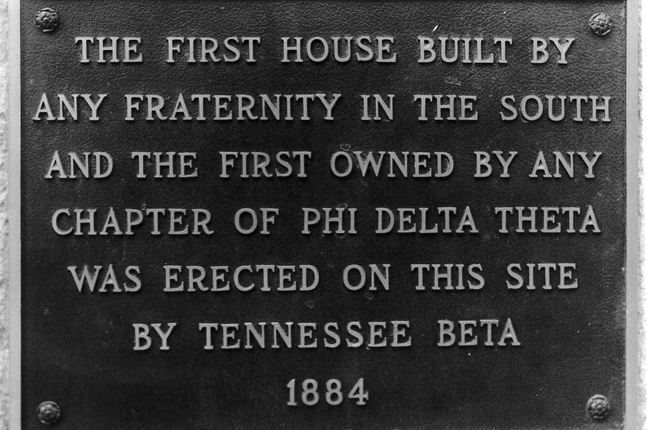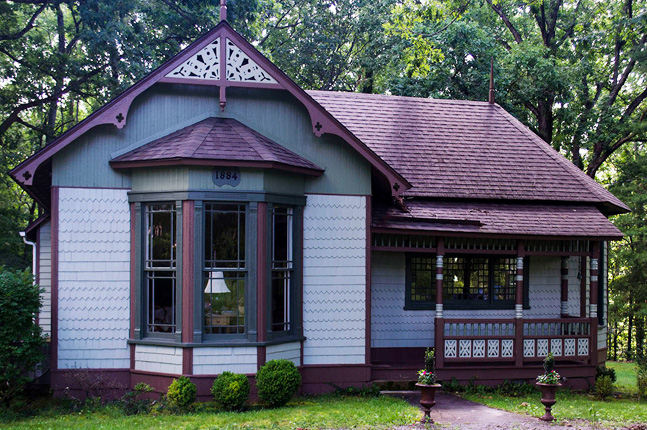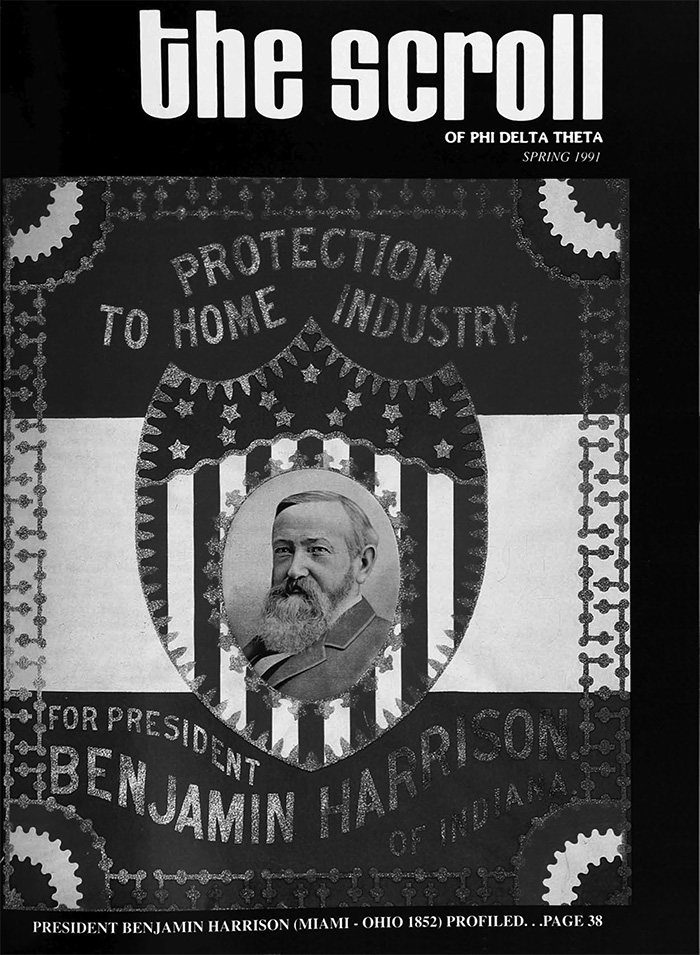One of the most important conventions ever held was in October 1880, in Indianapolis. This convention was the largest assembly held to-date by a fraternity, with twenty-eight chapter delegates and around 120 alumni members. At this convention, Walter B. Palmer and George Banta brought proposals for a new constitution to replace the informal Articles of Union, which were created in 1848.
Palmer and Banta believed the Articles of Union were inadequate, and that the Fraternity needed more uniformed rituals and overall organization. The convention adopted the revised constitution, and subsequently, the Grand Chapter was dissolved. The Executive Committee transformed into the new General Council, which had executive authority between conventions. The General Council was made up of an elected board, including a president, secretary, treasurer, and historian.
The original plan of government for Phi Delta Theta provided that the parent chapter at Miami should be the presiding chapter and should have the right to charter other chapters in Ohio. The first chapter in each state was granted the right to charter other chapters in the same state. The presiding chapter was called the Grand Chapter until 1868, when an executive committee was established. It had a president, a secretary, and a varying number of members. In 1872, its powers were enlarged, and a grand banker was added. From 1876 to 1880, it was composed of a president, a secretary, a grand banker, and one member chosen by the national Grand Chapter. Until 1878, the first chapter in each state was the presiding chapter in that area and was called the state Grand Chapter.
In 1880, the executive committee was changed to the General Council, composed of a president, a secretary, a treasurer, and a historian, and the Fraternity was divided into provinces. Full executive powers were then conferred on the General Council. In 1881, the Fraternity was incorporated under the laws of Ohio. In 1896, an officer known as the reporter was added to the General Council. The five councilors constituted the board of trustees, which acted as a court of appeals to decide questions of legal concern. In 1922, the offices of secretary and historian were abolished and those two officers became members-at-large of the General Council.
Since its inception in 1880, the Fraternity has had sixty-eight member serve as President of the General Council and 115 different members serve as a member of the General Council.
George Banta, Franklin ‘1876 was elected, by unanimous consent, as the first President of the General Council of Phi Delta Theta at the 1880 Convention at the Grand Hotel in Indianapolis. George, at the young age of 23 when elected, went on to serve as president through 1882. He eventually became known as a Second Founder of Phi Delta Theta. Much of what we know today – our ritual, the General Council, provinces, province presidents, countless chapters, and The Scroll – are tied back to the service of George Banta.
The Convention of 1880 is of great importance to all Phis. The Constitution adopted by this Convention made a change of great importance in the system of government. The Grand was abolished. The chapters were divided into provinces. All executive power was vested in a General Council of four members, selected by the National Convention, and in the Province Presidents, appointed by the General Council. The Fraternity had grown to be so large, and the labor of administrating its affairs so great, that some such arrangement as the province system was a necessity, in order to distribute the work among a greater number of officers.
The first Province Presidents in Phi Delta Theta were:
- Alpha Province, A. C. McCauley (Pennsylvania Alpha, 1881) – Vermont, Pennsylvania, Maryland
- Beta Province, Scott Bonham (Ohio Beta, 1882) – Ohio, Indiana
- Gamma Province, Milo C. Summers (Illinois Zeta, 1882) – Illinois, Missouri, Wisconsin, Michigan, Iowa
- Delta Province, Lyman Chalkley (Virginia Zeta, 1881) – Kentucky, Tennessee, Virginia
- Epsilon Province, J. M. Barrs (Tennessee Alpha, 1879) – North Carolina, South Carolina, Georgia, Alabama, Mississippi, Texas
George B. Thomas was editor of The Scroll in February 1883, when he announced that for the very first time the magazine contained reports from every chapter of Phi Delta Theta. It took a lot of hard work to accomplish this feat, including reaching out to some of the chapters multiple times. The Scroll had communications from forty-three active chapters and nine alumni chapters, which was a larger number than any other fraternity had at that time.
This achievement peaked envy from Beta Theta Pi, who in their own publication, bet that Phi Delt could not repeat this success. However, the next issue of The Scroll once again contained letters, or telegrams, from every single chapter.
In 1883 Tennessee Beta was chartered at Sewanee; within a year the chapter had erected the first Phi chapter house.
Arthur Ben Chitty, late historiographer at the University of the South, once called the Phi Delta Theta Fraternity House a “little gem of a building.” Modern day owners Mishoe Brennecke and Fred Croom have re-vitalized this Victorian structure.
Its history includes it as a one-time, school and later a fraternity house then private residence. The distinction of the house being the “first house to be built by any fraternity in the South.”
“The original structure contained only two rooms and a porch for it was designed as a meeting and recreation site rather than a home for full-time occupancy.”


The first printing of the Manual of Phi Delta Theta occurred in April 1896. Written by W. B. Palmer, it was fifty-four pages. The sections included were: I–Sketch of the Fraternity, II–Prominent Members, III–Statistics of the Fraternity, and IV–Statistics of Colleges. Palmer attributes the idea for such a publication to J. W. Mayer, CCNY 1884. He said, “The information containing the origin, progress, and present standing of Phi Delta Theta which this work presents is such as members of the Fraternity by all means should possess, but which heretofore has been very difficult for them to obtain. The book certainly has the merit of novelty, being the first of its kind ever issued.”
The edition costs 50 cents for a cloth edition or 30 cents for paper. The initial printing of four hundred copies quickly sold out. Several notable Phis commented on The Manual, including C. A. Foster, who said, “In regard to fraternity matters it is as indispensable as a Webster’s Unabridged to a student.”
World-renowned architect Frank Lloyd Wright was initiated into the Wisconsin Alpha Chapter on November 13, 1886
Wright became an American architect, interior designer, writer, and educator, who designed more than 1,000 structures, 532 of which were completed. Wright believed in designing buildings that were in harmony with humanity and its environment, a philosophy he called organic architecture. This philosophy was best exemplified by Fallingwater (1935), which has been called “the best all-time work of American architecture.” Wright was a leader of the Prairie School architecture movement and developed the concept of the Usonian home, his unique vision for urban planning in the United States. His creative period spanned more than seventy years.
His work includes original and innovative examples of many building types, including offices, churches, schools, skyscrapers, hotels, and museums. Wright also designed many of the interior elements of his buildings, such as furniture and stained glass. Wright wrote twenty books and many articles and was a popular lecturer in the United States and Europe. His colorful personal life often made headlines, most notably for the 1914 fire and murders at his Taliesin studio. Already well known during his lifetime, Wright was recognized in 1991 by the American Institute of Architects as “the greatest American architect of all time.”
One of the last buildings designed by Wright was Arizona Beta’s Chapter House. Even though Brother Wright died on April 9, 1959, the house was completed in the design he created in late 1961 and the chapter moved in in 1962.

Founding Father John McMillan Wilson passed away in 1874. In the 1886 edition of The Scroll, his biological brother, Archibald Wilson, wrote of the founder.
Archibald ended his telling of Brother Wilson’s life by signing with In Coelo Quies Est. This was the first time the phrase of farewell and godspeed had been used in Phi Delta Theta for a departed brother. It was voted at the 1890 Convention to be the official epitaph for those passing into the Chapter Grand. Today In Coelo Quies Est is translated to in heaven, there is rest.
Benjamin Harrison was the nineteenth member to sign the Bond and a member of Ohio Alpha before his political career ever started. In 1888, when he was named as the Republican Party presidential candidate, Benjamin Harrison was featured in a sixteen-page story, which included information about his college years, fraternity record, accomplishments in war, and accomplishments in law and politics. The editor of The Scroll concluded the article with the message that, “The Scroll is the organ of no political party, but…the nomination of our honored and worthy brother, General Harrison…is an honor which all Phis, irrespective of political ties, must feel with a keen sense of pride and gratification.” When Harrison won the election and took office in 1889, Phi Delta Theta was the first fraternity to see a brother be President of the United States of America.
Benjamin Harrison conducted one of the first “front-porch” campaigns, delivering short speeches to delegations that visited him in Indianapolis. As he was only 5 feet, 6 inches tall, Democrats called him “Little Ben”; Republicans replied that he was big enough to wear the hat of his grandfather, “Old Tippecanoe.”
In the Presidential election, Harrison received 100,000 fewer popular votes than Cleveland, but carried the Electoral College 233 to 168. Although Harrison had made no political bargains, his supporters had given innumerable pledges upon his behalf.
Read the original article from The Scroll.
Read A Tribute to Benjamin Harrison from the Spring 1991 edition of The Scroll.





